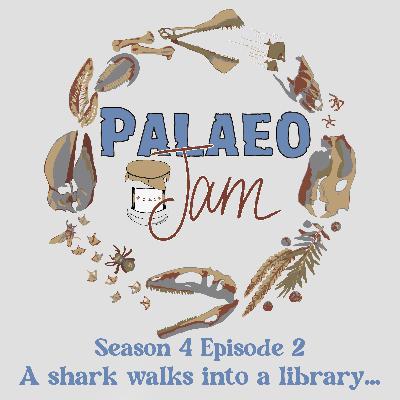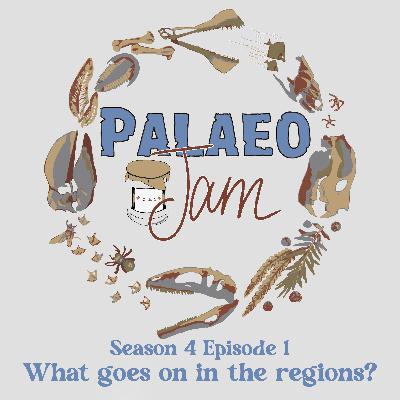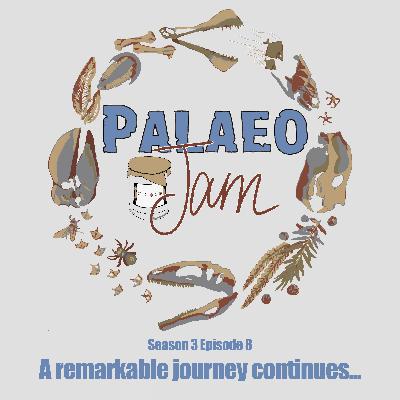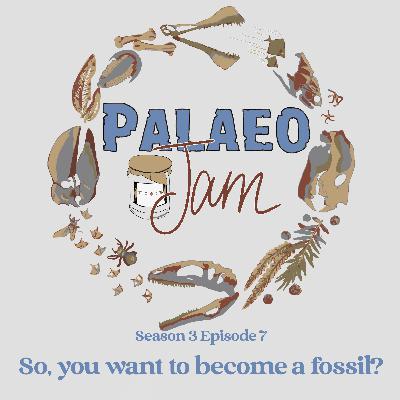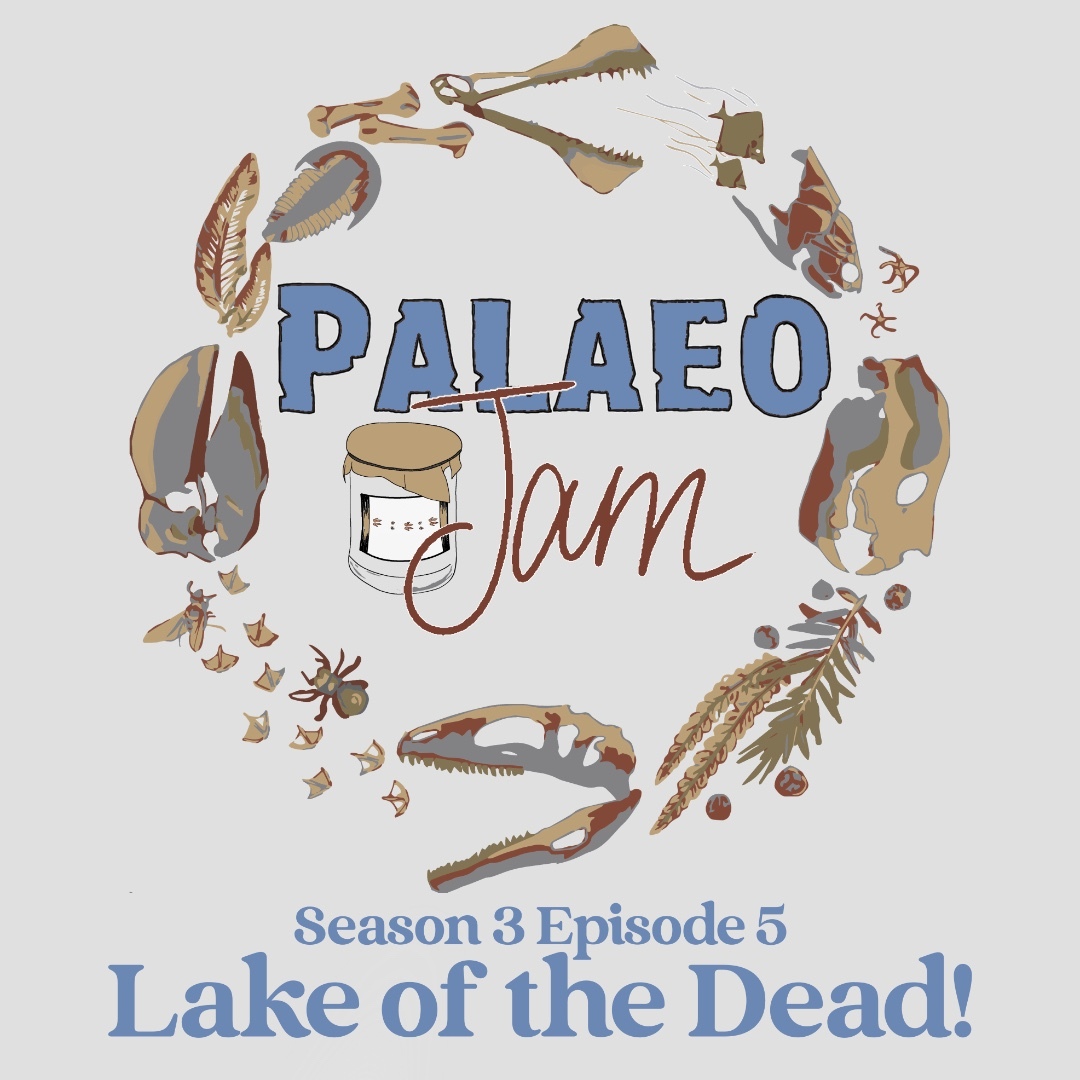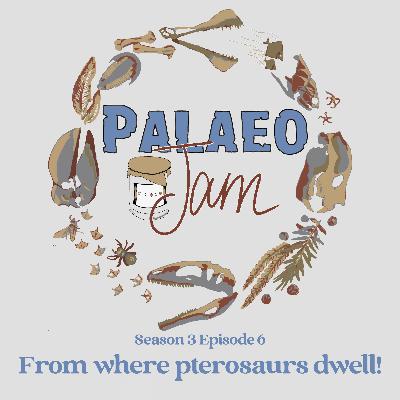Discover Palaeo Jam
Palaeo Jam

Palaeo Jam
Author: Dinosaur University
Subscribed: 6Played: 86Subscribe
Share
© Copyright 2022 All rights reserved.
Description
Palaeo Jam is a podcast exploring a range of issues in science and the community, using the multidisciplinary aspects of, and public fascination with, palaeontology. This Australian-produced palaeo podcast was launched at a publicly accessible live event at Flinders University, where the first two episodes were recorded in front of a live audience. Palaeo Jam uses fossils and other objects from palaeontology to explore a range of scientific and social issues, and incorporate key research and discoveries into its content. Each episode has a theme and it’s covered within a strict, 30-minute timeframe. Adding to the theatre of the recording, a timer is visible to the audience in live records. Each episode has a panel of up to three guests, and is hosted by Michael Mills, award-winning science communicator.
46 Episodes
Reverse
Australia is land of reptiles, and in particular, a land of lizards. How and when did it become this? And why are there so many venomous snakes? In this episode of Palaeo Jam, host Michael Mills chats with Dr Mark Hutchinson about the evolutionary history of the lizards of Australia, why they become a life long passion, if he has a favourite lizard, (he does, and explains why), and the rewards of being a research supervisor.
Dr Mark Hutchinson is an Australian herpetologist and palaeontologist, long associated with the South Australian Museum, where he served as Curator of Herpetology before becoming an Honorary Researcher. His work has focused on the taxonomy, evolution, and fossil history of reptiles—especially lizards and snakes—across Australia’s arid and southern regions. He has described numerous new species, reconstructed ancient ecosystems from fossil remains, and explored how climate shifts shaped reptile diversity. In addition to his museum role, Dr Hutchinson has held academic posts with the University of Adelaide and Flinders University, and is recognised internationally for his contributions to understanding the deep history and conservation of Australia’s reptiles.
Dr Mark suggests that if you want to learn about Australian lizards, a great intro is “Australian Lizards- A Natural History” by Steve Wilson. And if it’s more on Aussie snakes you’re after, “Australian Snakes: A Natural History” by Dr Richard Shine. Check your local book and ebook retailer for availability.
Host Michael Mills can be found on Insta as The HeapsGood Guy at https://www.instagram.com/heapsgood/
On Bluesky at https://bsky.app/profile/heapsgood.bsky.social
For all things HeapsGood, including links to Michael alter ego, Professor Flint, head to…
https://linktr.ee/heapsgoodproductions
And then what?
It tuned in to this very episode of Palaeo Jam!
Dr Heather Robinson and Professor John Long are the authors of two important books, “Beyond the Books: Culture, value and why libraries matter.” and “The Secret History of Sharks: The Rise of the Ocean's Most Fearsome Predators”, respectively.
Heather and John are also work partners and life partners, and in this episode of Palaeo Jam we explore the essence of each of their very different books, while attempting to find common ground. Along the way we ask, why do libraries matter? Indeed, why do cultural institutions matter? And why do sharks matter? In researching each of the books, what was the most surprising thing you discovered about libraries and sharks? And why are both of these books an important read, right now? Because, yes. They are!
You can find both books on-line, and at all good bookstores.
John’s paleontological CV is vast! A look through profile on The Conversation at https://theconversation.com/profiles/john-long-98402 will give you a small insight into John’s remarkable body of work.
Heather also has an extensive profile on The Conversation, at https://theconversation.com/profiles/heather-l-robinson-155358
Heather and John have created Lifecyle Productions as an instrument to work on a multitude of projects. Their company website is… https://lifecycleproductions.com.au/, and contains information about what they’re working towards, and about the skills they each bring.
We first chatted with Heather and John in episode 3 of season 1 titled "A Marriage of Art and Science" in which amongst other things, we explored the importance of their art/science collaborations, and the things they each bring to their working partnership, and delved into some of the delightful experiences that their working on things together as a married couple has brought them.
Michael and John have collaborated creatively through the creation of the Professor Flint song about the WA fossil emblem, the Gogo Fish. With lyrics by John, and music by Michael, the song features on the Professor Flint album, “Dinosaurs Amongst Us!”… The Gogo Fish song on Spotify
Regional museums in Australia and elsewhere are the custodians of a remarkable collection of stories. What are some of those stories, and why do they matter? Why, indeed, do regional museums matter? And what kinds of science, including palaeontology, takes place in the regions?
Palaeo Jam host Michael Mills recently travelled to Geraldton in Western Australia for a series of National Science Week events. The events were held at Blue Heelers Square and included a family show by emerging, all female dinosaur loving supergroup The Ammonites, a quiz night, and the recording of the first episode of Season 4 of the Palaeo Jam podcast. This is that recording, and we can’t think of a better way to begin our fourth season, than to chat about the importance of science and science engagement in the regions.
In this episode, Michael is joined by Dr Kailah Thorn, Project Coordinator (Biodiversity) Western Australian Museum, Lucy Stokes, Palaeontology PhD Candidate, Curtin University, and Sarah Walker, Learning and Engagement Officer, Western Australian Museum- Geraldton to discuss all things regional and science.
For more information on the Western Australian Museum, head to their website at…
https://visit.museum.wa.gov.au/
For more information on the awesome venue, Blue Heelers Square where we recorded this episode, head to…
https://www.blueheelerssquare.com.au/
For more information on The Ammonites, who we’ll hear from in a future episode, head to…
https://linktr.ee/theammonites
Just over 12 months ago, as part of National Science Week, we spoke with Eleanor Beidatsch, in an episode titled, “A Journey into accessibility: Digging for fossils from a wheelchair.” Since that episode, Eleanor has graduated from the University of New England with First Class Honours, been awarded the $130,000 #ElevateSTEM scholarship for postgraduate research from the Australian Academy of Technological Sciences and Engineering, and has started her Masters!
As we noted in the notes to last year’s episode, “as a nine year old, Eleanor dreamed of being a palaeontologist, but always presumed her advanced physical disability, and use of a wheelchair would make “digging about in the dirt for fossils” impossible.”
In this episode of Palaeo Jam host Michael Mills chats with Eleanor about another remarkable 12 months, and about what lies ahead as she continues her brilliant journey in the world of palaeontology, and follows her fascination with prehistoric velvet worms!
Check out this story from the ABC about Eleanor’s graduation…
https://www.abc.net.au/news/2024-05-26/eleanor-beidatsch-graduates-first-class-honours-geoscience/103839886
Here’s a link to last year’s episode with Eleanor…
https://palaeojam.podbean.com/e/a-journey-into-accessibility-digging-for-fossils-from-a-wheelchair/
Check out this video from Eleanor’s YouTube channel of her remarkable adventure in 2016, to a paleontological dig in the opal rich desert town of Lightning Ridge, New South Wales…
https://www.youtube.com/watch?v=aTGxIR_yaNo
Here’s a story about Eleanor’s journey on the University of New England’s website…
https://www.une.edu.au/connect/news/2022/09/unearthing-discrimination-in-science
Along with studying palaeontology, Eleanor is a disability rights journalist, and writes for the ABC…
https://www.abc.net.au/news/eleanor-beidatsch/101651018
Here’s a link to the Elevate STEM website…
https://www.atse.org.au/what-we-do/pathways-into-through-stem/elevate/
You can find Eleanor on Instagram at…
https://www.instagram.com/eleanor.beidatsch/
And on Twitter at…
https://twitter.com/EBeidatsch
Here’s a link to Eleanor’s blog Accessible 4 Me…
https://accessible4me.wordpress.com/
For more information on the research being undertaken by the team at University of New England’s Palaeoscience Research Centre, head to
https://www.une.edu.au/research/research-centres-institutes/palaeoscience-research-centre
You can find Michael at @heapsgood https://twitter.com/Heapsgood
To connect with Dinosaur University on Facebook, follow us at https://www.facebook.com/DinosaurUniversity
At Palaeo Jam, we now have an Instagram account at https://www.instagram.com/palaeo_jam
So, you want to become a fossil? Good luck with that! There’s a whole sequence of things that need to take place in order for that to happen, and in this episode of Palaeo Jam, we explore those steps, and how unlikely it is that you will be able to complete all of them.
Recorded underground in Blanch Cave, in the Naracoorte Caves, South Australia, this episode sees host Michael Mills in conversation with PhD candidate Nerita Turner. Nerita’s work focuses on the modes of accumulation of large animal remains in caves, and we explore the unlikelihood becoming a fossil through the lens of her work. In order to become a fossil in a cave, you need to get into a cave in the first place. How does this impact on the size and kinds of animals that might then become fossils within a cave?
During the conversation Nerita describes the fossil record as “Infamously incomplete”. So, how incomplete is it? Consider the following… There are 1400 dinosaur species of dinosaurs that have been discovered and named across the entire Mesozoic, while right now there are around 11 000 species of living dinosaurs, in birds. How many dinosaur species lived across the entire 186 million year period of the Mesozoic? We will never know.
Of course, what we do know, is truly remarkable, and a testament to the work of so many. Palaeontology is able to provide us with some remarkable insights into past lives. to uncover past lives. It is important, however, to understand, that we get to see will only ever be a tiny glimpse of the extraordinary natural history, of this most astonishing planet.
Nerita Turner is a PhD Candidate at the University of Adelaide. Her research focuses on the modes of accumulation of large animal remains in caves, with a particular focus on fossil sites within the Naracoorte Caves region.
You can find Nerita on Twitter at https://twitter.com/nerita_turner
Check out the following article, by Nerita and Dr Elizabeth Reed…
“Using historical research to constrain the provenance and age of the first recorded collection of extinct Pleistocene large mammal fossils from the Naracoorte Caves, South Australia.”
https://www.tandfonline.com/eprint/M7JARRBWBXBWDCFDGIIY/full?target=10.1080/03721426.2023.2188442
Michael occasionally pops in to the strange place that is Twitter at @heapsgood https://twitter.com/Heapsgood
To connect with Dinosaur University on Facebook, follow us at https://www.facebook.com/DinosaurUniversity
At Palaeo Jam, we now have an Instagram account at https://www.instagram.com/palaeo_jam
Tens of thousands of years ago, in and around what is known as Lake Callabonna, in outback South Australia, all manner of now extinct Australian animals dwelt. But whether they walked, or slithered, or crawled, or hopped, or flew, or swam in that place, it was soon to become what has been described in an ABC Australia documentary series as the “Lake of the Dead”.
In this episode of Palaeo Jam we travel back in time with host Michael Mills, and Dr Aaron Camens and Dr Phoebe McInerney of Flinders University to find who it was that once lived in and around this “Lake of the Dead”, and what it might have been like had we the ability to transport ourselves, and take a stroll along the banks of what was once a heathy, freshwater ecosystem.
You can hear more from both Aaron and Phoebe, and several other past Palaeo Jam guests in the remarkable two-part series, from ABC Australia’s Catalyst, in “Megafauna: What Killed Australia’s Giants?”. Head to the ABC iView site at https://iview.abc.net.au/ and search for the series there.
You can follow Aaron on Twitter at https://twitter.com/DiprotoRon, and check out his Flinders University profile at https://sites.flinders.edu.au/palaeontology/home/people/academics/aaron-camens/
Amongst his extensive research work, Aaron co-authored a paper that gave us a more complete picture of the largest marsupial predator known, and a former resident of the area, Thylacoleo carnifex…
https://journals.plos.org/plosone/article?id=10.1371/journal.pone.0208020
Phoebe is on Twitter at https://twitter.com/Phoebyornis
Check out her recent article in The Conversation about the skull of Genyornis, discussed in this episode…
https://theconversation.com/new-fossils-show-what-australias-giant-prehistoric-thunder-birds-looked-like-and-offer-clues-about-how-they-died-out-221599
You can find host Michael Mills on Twitter at @heapsgood https://twitter.com/Heapsgood
To connect with Dinosaur University on Facebook, follow us at https://www.facebook.com/DinosaurUniversity
At Palaeo Jam, you can also follow our Instagram account at https://www.instagram.com/palaeo_jam
What happens when two people who create palaeontology podcasts get together for a chat? Tune in to find out!
In this episode of Palaeo Jam, host Michael Mills chats with vertebrate Palaeontologist and expert in Australian pterosaurs Adele Pentland of the “Pals in Palaeo” podcast about Australian pterosaurs, about each of their podcasts, and about science heroes.
Along the way we get an insight into where Australian pterosaurs fit within the global pterosaur community, come to understand why science communication matters, and how it is that their palaeontology podcasts are a thing!
You can find Adele’s awesome podcast, “Pals in Palaeo” through the following link… https://linktr.ee/palsinpalaeo
Be sure to follow the podcast on Instagram at https://www.instagram.com/palsinpalaeo/
You can also head to the Pals in Palaeo website at https://palsinpalaeo.com/
Here’s a link to an article by Adele about Ferrodraco lentoni… the pterosaur that Adele named, and that we discuss in the podcast…
https://theconversation.com/4-metre-flying-reptile-unearthed-in-queensland-is-our-best-pterosaur-fossil-yet-124581
And here’s a link to another article by Adele of the fascinating pterosaurs that are being discovered in Australia… https://theconversation.com/these-magnificent-107-million-year-old-pterosaur-bones-are-the-oldest-ever-found-in-australia-206501
Speaking of pterosaurs, there’s a song about pterosaurs on the Professor Flint/Gemma Dandie album, “These Curious Things”, and you can watch a video of the song here… https://youtu.be/_ZJzRVO8ZK4?si=w2r39cTFVmiRijTo
You can find links to the album, and more information about Michael’s science hero Mary Anning, here… https://linktr.ee/thesecuriousthings
You can find Michael on Twitter at @heapsgood https://twitter.com/Heapsgood
To connect with Dinosaur University on Facebook, follow us at https://www.facebook.com/DinosaurUniversity
At Palaeo Jam, we now have an Instagram account at https://www.instagram.com/palaeo_jam
May 7th has come to be known as Australia’s National Dinosaur Day! A day in which Australians are being asked to celebrate the remarkable dinosaurs that once walked where we now walk. Or as we like to call them, the Dinosaurs Down Under!
What is the significance of May 7th? And how did this date, in particular, become the day now known as Australia’s National Dinosaur Day?
Phil Hore has worked in a lot of cool places, including the Smithsonian, the Field Museum and the Australian Dinosaur Museum! He’s also written lots, including as a regular writer for The Prehistoric Times. In this special edition of Palaeo Jam to celebrate Australia’s National Dinosaur Day, host Michael Mills chats with Phil about where the idea for the day came from, how it has grown in recent years, why Australian dinosaurs matter, and what his key role has been in making this a day to remember!
You can find Australia’s National Dinosaur Day on Facebook at…
https://www.facebook.com/Australiannationaldinosaurday
If you’re ever in Rockhampton, be sure to check out Phil’s Time Safaris Walking Tours…
https://www.timesafaris.com.au/
https://www.facebook.com/timesafaris
Phil has been known to Tweet now and again at https://twitter.com/Phil_Hore
Here’s a link to The Prehistoric Times magazine…
https://pocketmags.com/au/prehistoric-times-magazine
Michael Mills’ alter ego, singing palaeontologist Professor Flint, released a brand new version of the “Dinosaurs Down Under” album, earlier this year. You can find it, and other Prof Flint things, here…
https://linktr.ee/ProfessorFlint
You can find Michael at @heapsgood https://twitter.com/Heapsgood
To connect with Dinosaur University on Facebook, follow us at https://www.facebook.com/DinosaurUniversity
At Palaeo Jam, we have an Instagram account at https://www.instagram.com/palaeo_jam
We’re back for Season 3, and we begin in the palaeo lab at Flinders University!
We’re delighted that in this first episode of the new season, Palaeo Jam host Michael Mills chats with Dr Isaac Kerr about a remarkable research paper, just published, that seeks to more clearly define what is and what isn’t a Protemnodon… AKA a giant, prehistoric kangaroo!
During the course of the conversation, we hear from Isaac about the features that define this particular group of giant, prehistoric marsupials, but also, the fascinating differences amongst them. We talk about about who’s in, and who’s out of the genus, and along the way, we hear about the fascinating ways in which these extraordinary kangaroos lived their lives, depending upon where they lived. As a bonus, we also hear about how Isaac and his team were able to ditch a previously described species by none other than Sir Richard Owen!
You can follow Dr Isaac Kerr on Twitter at @isaacarkerr https://twitter.com/IsaacARKerr
You can read the full 250 plus pages of this remarkable paper, here…
https://mapress.com/mt/article/view/megataxa.11.1.1
Check out the following article by Isaac in The Conversation…
https://theconversation.com/we-found-three-new-species-of-extinct-giant-kangaroo-and-we-dont-know-why-they-died-out-when-their-cousins-survived-227857
Here’s a link to the Flinders University palaeo team…
https://sites.flinders.edu.au/palaeontology/
And here’s an article on the ABC about this amazing paper…
https://www.abc.net.au/news/2024-04-15/three-unique-extinct-kangaroo-species-discovered-flinders-uni/103699606
You can find Michael Mills at @heapsgood https://twitter.com/Heapsgood
To connect with Dinosaur University on Facebook, follow us at https://www.facebook.com/DinosaurUniversity
At Palaeo Jam, we now have an Instagram account at https://www.instagram.com/palaeo_jam
Following the world premiere of “A Curious Thing- The story of Mary Anning” at the 2023 Adelaide Fringe, Palaeo Jam host, and writer/director of the Mary Anning Fringe show Michael Mills sat down with three brilliant women in science to explore their thoughts on the show, its themes, Mary’s legacy, and their own experiences as women in science.
In a wide ranging discussion, Flinders University space archeologist, Dr Alice Gorman, University of Adelaide Palaeontologist Dr Liz Reed, and University of Adelaide PhD Candidate Tiah Bampton speak about key moments in their lives, role models that have inspired them, and give some important insights into some of the challenges still faced by women in science, 176 years after Mary Anning’s death.
The podcast ends with each guest being asked the one thing they might say to Mary Anning, had they the opportunity to do so.
You can find Dr Alice Gorman on Twitter at @drspacejunk https://twitter.com/drspacejunk
Amongst many things, Alice has written extensively for The Conversation, including a recent article, “Prejudice, poor pay and the ‘urinary leash’: naming and claiming Australia’s forgotten women scientists”.
Read the article here… https://theconversation.com/prejudice-poor-pay-and-the-urinary-leash-naming-and-claiming-australias-forgotten-women-scientists-198407
And if you don’t already have a copy, find yourself a copy of Alice’s book, “Dr Space Junk vs The Universe: Archaeology and the Future.”
You can find Dr Liz Reed on Twitter at… @LizReed_palaeo https://twitter.com/LizReed_palaeo
Liz’s extensive profile, with links to research papers and articles can be found at… https://researchers.adelaide.edu.au/profile/liz.reed
Liz appeared on a previous episode of Palaeo Jam in which she and host Michael Mills chatted about the importance of caves not just as repositories of fossils, but as living ecosystems, while sitting in Blanch Caves in the Naracoorte Caves of South Australia. Check out the episode here… https://www.podbean.com/ew/pb-rnthh-1379952
To learn about Tiah Bampton’s journey, and the delightful connection to PhD supervisor Dr Liz Reed, tune in to the podcast! And also check out this story with the ABC… https://www.abc.net.au/news/2020-05-03/tiah-bampton-living-dream-at-naracoorte-caves-palaeontology-dig/12209876
You can check out Tiah’s research profile here… https://www.researchgate.net/profile/Tiah-Bampton And read the paper referred to in the Research gate link, here… https://helictite.caves.org.au/pdf1/46.Bampton.pdf
Palaeo Jam host Michael Mills can be found on Twitter as @heapsgood https://twitter.com/Heapsgood
For more on the work Michael and HeapsGood Productions have been involved with in exploring the story of Mary Anning, check out the link… https://linktr.ee/TheseCuriousThings
Imagine you’re that dinosaur kid! The one who knows all the names of all the things, and dreams of one day going to university to study palaeontology in order to become a palaeontologist. Of course, most dinosaur kids don’t get to do that. But imagine you are one who makes it. You do get accepted into a palaeontology degree, and even better, make it through the first year!
In this episode of Palaeo Jam, host Michael Mills chats with three students who’ve just completed their first year of a palaeontology degree at Flinders University. During the episode, we find out from Dylan Slinn, Natalie Jackson and Thomas Khajeh, what brought them to Flinders University, what they were expecting when they got here, and how it turned out across the year, both good and bad.
So, why the title of the episode, “The Dinosaur Kids… Part 1”? At the end of the episode, we get a very definite commitment from all three to get back together at the end of second year, and record a follow-up episode. That’ll be Part 2… and we’re pretty sure we’ll get a Part 3 and beyond as we follow the journey of these three dinosaur kids in pursuit of their dream! We can’t wait to see how the journey for each of them unfolds!
You can find Natalie at:
Tik Tok - @nataliemaree_art https://www.tiktok.com/search?q=nataliemaree_art
Twitter - @PalaeoNat https://twitter.com/PalaeoNat
Thomas’ sister's Insta is at @thelostgirldraws https://www.instagram.com/thelostgirldraws/
Her etsy is at https://www.etsy.com/shop/LizzysStickerCo
Dylan Slinn can be found as Dylan Slinn on Facebook
Michael on Twitter at @HeapsGood https://twitter.com/Heapsgood
And Dinosaur University on Twitter at @DinosaurUni https://twitter.com/DinosaurUni
And Facebook at @DinosaurUniversity https://www.facebook.com/DinosaurUniversity
The dinosaur book Natalie talks about is “The Complete Illustrated Encyclopedia of Dinosaurs & Prehistoric Creatures” by Dougal Dixon It can be found online at Book Depository, Dymocks and Booktopia.
Matrescence has been defined as “the physical, emotional, hormonal and social transition to becoming a mother.”
In a recent blog titled “Palaeo-matrescence”, Dr Alice Clement noted the following…
“I wanted to seek advice from colleagues who had navigated the same journey as me, but it was difficult to find people in the same boat. I could see plenty of “parents in palaeo”, but looking for mothers (in the traditional, biological sense) was a harder task. Where are they all?”
In this episode of Palaeo Jam, host Michael Mills is joined by Alice, and Dr Vera Weisbecker, to discuss the impact and challenges having children has had on the careers of women in palaeontology, and whether or not things have changed over the years.
To Alice’s full blog, head to… https://draliceclement.com/2022/07/06/palaeo-matrescence/
For more of Alice’s blog posts, check out https://draliceclement.com, and follow Alice on Twitter at https://twitter.com/DrAliceClement.
Dr Vera Weisbecker is an evolutionary developmental morphologist, which is a fancy way of saying she likes to study the diversity of Australian land vertebrates in all their glory. You can follow Vera on Twitter at https://twitter.com/WeisbeckerLab
Vera has just finished developing a game to transmit her team’s love for Australian present and past biodiversity and the evolutionary process behind it. It’s called “Go Extinct! Megafauna edition”. It can be downloaded for free through the Centre of Excellence for Australian Biodiversity and Heritage… https://epicaustralia.org.au/resource/goextinctmegafauna/
Palaeontology is often seen as one of the cool sciences, if not the coolest, because, of course, it’s the one with dinosaurs!
Is there more to it, though?
Don’t get us wrong… dinosaurs are awesome!
Does palaeontology have any practical use to the community? Is there any real value beyond thinking it’s cool, that palaeontology brings to the table?
In this episode of Palaeo Jam, host Michael Mills is joined by Dr Aaron Camens, (lecturer in palaeontology at Flinders University), and Pheobe McInerney, (PhD Candidate at Flinders University) to discuss all the things, and what they think makes palaeontology such a valuable science.
In pondering this very issue, Aaron recently said…
“The fossil record records diversity but it is much more than that. It contains abundant data about how past ecosystems have functioned, the kinds of habitats extinct organisms used to live in and their environmental tolerances. Without the fossil record we wouldn’t understand nearly as much as we do about how today’s ecosystems will respond to change going into the future…”
You can follow Aaron on Twitter at https://twitter.com/DiprotoRon, and check out his Flinders University profile at https://sites.flinders.edu.au/palaeontology/home/people/academics/aaron-camens/
Amongst his extensive research work, Aaron co-authored a paper that gave us a more complete picture of the largest marsupial predator known, Thylacoleo carnifex. https://journals.plos.org/plosone/article?id=10.1371/journal.pone.0208020
Phoebe is on Twitter at https://twitter.com/Phoebyornis Check out her recent article in The Conversation about disease in giant prehistoric birds, and how we know about it.
https://theconversation.com/fossil-find-reveals-giant-prehistoric-thunder-birds-were-riddled-with-bone-disease-173745
In this introductory, test episode, Steve Davis from The Adelaide Show Podcast asks producer, Michael Mills, from Heaps Good Productions, about the content and the rationale for the Palaeo Jam Podcast.
In this episode of Palaeo Jam, host Michael Mills begins the conversation with Dr Natalia Jagielska, Engagement & Collections Curator at the Lyme Regis Museum by chatting about palaeontology pioneer Mary Anning, and what it means to be working in the very space Mary’s home in Lyme Regis once occupied. As the conversation continues, we learn about the first pterosaur ever found in Scotland, Dearc sgiathanach, and what it tells us about pterosaur evolution. In so doing, we reflect on the unique connection between Natalia and Mary, given Mary’s discovery of the first known pterosaur in England, Dimorphodon macronyx. The two also discuss a subject central to both Natalia and Michael’s professional working life, the connection between art and science.
This is the first episode of Palaeo Jam to feature a guest from beyond the shores of Australia. May there be many more!
Head to Natalia’s website to see links to her research, public outreach, and awesome palaeo art…
https://natalia-jagielska.weebly.com/
You can find Natalia on Twitter at… @wrycritic
https://x.com/WryCritic
To access the original paper, authored by Natalia et al on the Scottish pterosaur Dearc sgiathanach, head to…
https://www.sciencedirect.com/science/article/pii/S096098222200135X
For links to the Lyme Regis Museum, check out…
https://linktr.ee/lymemuseum
There’s a song about pterosaurs on the Professor Flint/Gemma Dandie album, “These Curious Things”, and you can watch a video of the song here… https://youtu.be/_ZJzRVO8ZK4?si=w2r39cTFVmiRijTo
You can find links to the album, and more information about Mary Anning, here… https://linktr.ee/thesecuriousthings
Michael occasionally pops in to the strange place that is Twitter at @heapsgood https://twitter.com/Heapsgood
To connect with Dinosaur University on Facebook, follow us at https://www.facebook.com/DinosaurUniversity
At Palaeo Jam, we now have an Instagram account at https://www.instagram.com/palaeo_jam
This is the second episode in Season 3 in which pterosaurs feature. Check out Episode 3 in which Michael chats with vertebrate Palaeontologist and expert in Australian pterosaurs Adele Pentland of the “Pals in Palaeo” podcast about Australian pterosaurs, about each of their podcasts, and about science heroes…
https://palaeojam.podbean.com/e/me-and-my-palaeo-pal/
In 1990, Mike Cleland was fossicking around a coastal region of the state of Victoria in Australia, when he came across a fossil discovery that was to change his life. The fossil he discovered was to become known as Koolasuchus cleelandi, and in 2022, Koolasuchus to became the state’s official fossil emblem, following a public vote.
In this episode of Palaeo Jam, host Michael Mills chats with Mike, and Lesley Kool, after whom the first part of Koolasuchus, was named, about this extraordinary, prehistoric amphibian. Along the way, we discover Lesley’s role in the discovery and understanding of this remarkable fossil, and what it is about this car sized amphibian that makes it such a worthy fossil emblem.
For more information on the region where Koolasuchus was found, head to…
http://dinosaurdreaming.monash.edu/
You can also check out the Dinosaur Dreaming blog at…
http://dinodreaming.blogspot.com/
And find out more about the Victorian coastal dinosaur trail, here…
https://engage.basscoast.vic.gov.au/dino
You can find host Michael Mills on Twitter at @heapsgood https://twitter.com/Heapsgood
To connect with Dinosaur University on Facebook, follow us at https://www.facebook.com/DinosaurUniversity
At Palaeo Jam, you can also follow our Instagram account at https://www.instagram.com/palaeo_jam
There’s something quite delightful about seeing the skeleton of a prehistoric animal move in a way that it might have moved when the bones were covered in flesh, and the animal was alive. Jack O Conner is a PhD candidate at Monash University, and that’s exactly what he's doing at the Evans EvoMorph Lab.
In this episode of Palaeo Jam, host Michael Mills chats with Jack about how he came to be doing what he does, explores the process of creating the models, and what it’s like to see such creatures brought to life in this way. Such work, of course, fits well into the science communication field for which Michael has built a career, and both Michael and Jack discuss some of the important elements of science communication, and why it matters.
You can find Jack’s models of Thylacoleo carnifex, Zygomaturus trilobus, Siderops kehli, and Perucetus colossus on Sketchfab at…
https://skfb.ly/oPsJs
We think it’s well worth checking out the models before you listen to the podcast if you can, or even while you’re listening to it.
Be sure, too, to check out our episode on the Virtual Australian Museum of Palaeontology (VAMP), at https://palaeojam.podbean.com/e/vamp-it-up/ to hear about where some of the source material come from for Jack’s work. It is an absolutely brilliant resource.
You can follow Jack O’Conner on Instagram at @jackodesign
https://www.instagram.com/jackocdesign/
And follow Monash Science at @monash_science
https://www.instagram.com/monash_science/
The Evans EvoMorph Lab is on Twitter at @EvansEvoMorph
https://twitter.com/evansevomorph
You can find Palaeo Jam host Michael Mills on Twitter at @heapsgood https://twitter.com/Heapsgood
To connect with Dinosaur University on Facebook, follow us at
https://www.facebook.com/DinosaurUniversity
On Instagram at @dinosauruniversity
https://www.instagram.com/dinosauruniversity/
And on Twitter at @DinosaurUni
https://twitter.com/DinosaurUni
Palaeo Jam also now has its own Instagram account at @palaeo_jam
https://www.instagram.com/palaeo_jam
Australia is currently home to 17 species of hawks and eagles. Tens of thousands of years ago, however, there were more. What were they like? What happened to them? And what can we learn about past ecosystems and the extinction that wiped out the Australian mega-fauna, in studying such prehistoric birds?
In this episode of Palaeo Jam, host Michael Mills chats with Dr Ellen Mather, Adjunct Associate lecturer at Flinders University discuss all of these things and more, as they talk about several extinct species of eagle, including a much somewhat “chunky” eagle that could have plucked koalas from the tree!
You can read more in The Conversation article authored by Ellen, Professor Mike Lee, and Associate Professor Trevor Worthy…
“Giant eagles and scavenging vultures shared the skies of ancient Australia”
https://theconversation.com/giant-eagles-and-scavenging-vultures-shared-the-skies-of-ancient-australia-216358
Here’s a direct link to the research…
“Pleistocene raptors from cave deposits of South Australia, with a description of a new species of Dynatoaetus (Accipitridae: Aves): morphology, systematics and palaeoecological implications”
https://www.tandfonline.com/doi/full/10.1080/03115518.2023.2268780
A great article examining Ellen’s recent work on the discovery of vultures in Australia can be found here…
https://theconversation.com/it-was-long-thought-these-fossils-came-from-an-eagle-turns-out-they-belong-to-the-only-known-vulture-species-from-australia-187017
Ellen was also co-author for an article on a prehistoric species of eagle… https://theconversation.com/meet-the-prehistoric-eagle-that-ruled-australian-forests-25-million-years-ago-168249
You can find Ellen on Twitter at @Ellenaetus
https://twitter.com/Ellenaetus
Ellen previously spoke to us on Palaeo Jam in the following episode…
Season 1, Episode 5
“Vultures and flamingoes Down Under?
https://palaeojam.podbean.com/e/vultures-and-flamingoes-down-under/
You can find Palaeo Jam host Michael Mills on Twitter at @heapsgood https://twitter.com/Heapsgood
To connect with Dinosaur University on Facebook, follow us at
https://www.facebook.com/DinosaurUniversity
On Instagram at @dinosauruniversity
https://www.instagram.com/dinosauruniversity/
And on Twitter at @DinosaurUni
https://twitter.com/DinosaurUni
Palaeo Jam also now has its own Instagram account at @palaeo_jam
https://www.instagram.com/palaeo_jam
The fossil record of Theropod dinosaurs in Australia is sparse, and our understanding of them is poor. In a recent publication of the first chapter of his PhD, PhD Candidate Jake Kotevski is on his way to changing that.
In this episode of Palaeo Jam, host Michael Mills chats with Jake about the recent identification of the oldest-known Megaraptorid skull fragment, found on an Eastern Victorian beach in Australia, nearly 20 years ago. What does this unique and important fragment tell us about Australian Theropods and their place in the world? In just one of the concepts they discuss, it supports the theory that Megaraptorids originated in Australia. Tune in for more!
To read the paper, “A megaraptorid (Dinosauria: Theropoda) frontal from the upper Strzelecki Group (Lower Cretaceous) of Victoria, Australia”, head to… https://www.sciencedirect.com/science/article/pii/S0195667123002975#sec7
You can find Jake on Twitter at @Dinoman_Jake
https://twitter.com/Dinoman_Jake
And on Instagram at @theropods_down_under
https://www.instagram.com/theropods_down_under/
The Evans EvoMorph Lab where Jake is based for his PhD is on Twitter at @EvansEvoMorph
https://twitter.com/evansevomorph
For information on visiting the Dinosaur Dreaming site mentioned in the podcast, head to…
https://www.visitgippsland.com.au/do-and-see/arts-culture-and-heritage/historical-towns-attractions/dinosaur-dreaming
And also Bunurong Coast Education at http://sgcs.org.au/programs.php
You can find Palaeo Jam host Michael Mills on Twitter at @heapsgood https://twitter.com/Heapsgood
To connect with Dinosaur University on Facebook, follow us at
https://www.facebook.com/DinosaurUniversity
On Instagram at @dinosauruniversity
https://www.instagram.com/dinosauruniversity/
And on Twitter at @DinosaurUni
https://twitter.com/DinosaurUni
Palaeo Jam also now has its own Instagram account at @palaeo_jam
https://www.instagram.com/palaeo_jam
In August 2023, Michael Mills travelled to various communities in Australia, to record multiple episodes of the Palaeo Jam podcast for National Science Week. One of the enduring conversations born of the tour was how a community might engage with its local fossil heritage, and
In this episode, recorded in Naracoorte, South Australia, in front of a live audience, we discuss a range of ideas of what local communities might do to better engage, and what the challenges and opportunities might be.
Do you know the fossil heritage of where you live? Do you have any ideas for better engaging your local community with that heritage? And even if you do, do you know how to go about doing something about it?
In the 15th episode of this season recorded for National Science week, host Michael Mills explores the possibilities with Site Manager, Naracoorte & Tantanoola Caves, Tom Short; University of Adelaide PhD candidate Nerita Turner; Site Interpreter at Naracoorte Caves National Park, Georgia Blows, and with an awesome appearance towards the end from Isla aged 9 and Quinny, aged 7.
Thanks to the Naracoorte Lucindale Council whose commitment to engaging with their community has helped make this project possible. You can find them on Facebook at… https://www.facebook.com/naracoortelucindalecouncil
And their website at https://www.naracoortelucindale.sa.gov.au/
You can find Palaeo Jam host Michael Mills on Twitter at @heapsgood https://twitter.com/Heapsgood
To connect with Dinosaur University on Facebook, follow us at https://www.facebook.com/DinosaurUniversity
We’ve recorded several episodes in Naracoorte across both seasons of Palaeo Jam. Subscribe now to listen to the rest, in which we chat about the fossils of the Caves while in the Caves. Here are direct links to 3 Naracoorte episodes.
“Professor Wells and the Chamber of Secrets” with Professor Rod Wells…
https://palaeojam.podbean.com/e/professor-wells-and-the-chamber-of-secrets/
“Caves- Ecosystems of the past, the present and the future” with Dr Elizabeth Reed…
https://palaeojam.podbean.com/e/caves-ecosystems-of-the-past-the-present-and-the-future/
“A Career in a Cave”, with Nicola Bail, Nerita Turner and Georgia Blows.
https://palaeojam.podbean.com/e/a-career-in-a-cave/



